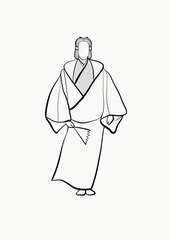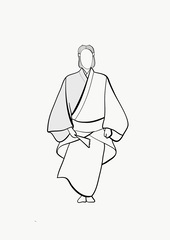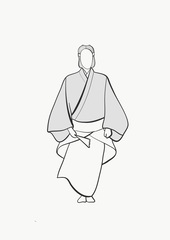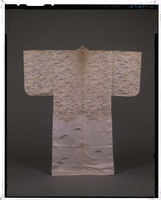Surihaku
すりはく 摺箔
A surihaku is a small-sleeved (kosode 小袖) noh costume of soft silk patterned with stenciled gold or silver foil and worn for women's roles under karaori 唐織 or nuihaku 縫箔 . Although often glimpsed only at the upper chest, in some outfits the left sleeve or the whole upper portion of the surihaku is exposed.
Noh Kyogen
Roles and Draping
Surihaku are undergarments worn primarily for women's roles. The surihaku is laid over the actor's shoulders, crossed snugly over the chest, left lapel over right, and then bound at the waist with a sash. For a standard woman's role in the first half of a noh, a karaori is draped in kinagashi style with the collar left open, which leaves only a small portion of the surihaku visible. For roles of women who are crazed (Sakagami in Semimaru 蝉丸) or doing manual labor (Courtesan in Eguchi 江口), the karaori is draped in nugisage style, with the right sleeve slipped off, so the surihaku is exposed on half the torso. The entire upper portion of the surihaku is visible when combined with a nuihaku folded down at the waist in koshimaki draping (Hagoromo 羽衣).



Textile Features and Tailoring
While Momoyama-period surihaku are generally made from plain weave silk with glossed wefts (nerinuki), Edo-period ones tend to be made of satin (shusu), warp-faced twill (aya), or figured satin (rinzu). Repeat patterns are cut into paper stencils (katagami). The stencils are placed onto the fabric, adhesive applied through the holes, and then metallic foil (gold or silver) placed over the stenciled area while the adhesive is still wet. When it dries, excess foil is brushed off to reveal the pattern, which is repeated over the entire costume, or only in designated areas. Often the lower portion of a surihaku has little or no decoration, as it is always covered up when worn.
Designs and Coloring
Repeat geometric patterns, like checker blocks, interlocking circles or triangles, woven fence, and key-fret designs are common. Free-flowing designs, like scrolling vines, wind-bent grass, or swirling water create poetic effect. The majority of surihaku are white; but red, light blue and yellow one are also found, as well as ones with bands of differing colors. When bits of embroidery are used as highlights the costume is called a nui-iri surihaku.

Surihaku with design of dew-laden grasses on a white ground. 18th century. Tokyo National Museum.
http://webarchives.tnm.jp/imgsearch/show/C0019074
Contributor
Monica Bethe